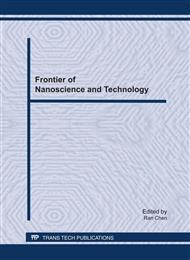[1]
R.X. Wang, Q.P. Wu, Y.Z. Wu, Use of nanoparticles to make mineral oil lubricants feasible for use in a residential air conditioner employing hydro-fluorocarbons refrigerants, Energy and Buildings, 42 (2010) 2111-2117.
DOI: 10.1016/j.enbuild.2010.06.023
Google Scholar
[2]
Y.I. Mohammed, B. Jocelyn. The effect of oil in refrigeration: Current research issues and critical review of thermodynamic aspects, Int. J. Refrigeration,31 (2008) 165-179.
DOI: 10.1016/j.ijrefrig.2007.09.006
Google Scholar
[3]
R.X. Wang, B. Hao, G.Z. Xie, A refrigeration system using HFC134a and mineral lubricant appened with n-TiO2(R) as working fluids. In: proceedings of 4th Int. Symposium on HVAC. Tsinghua University Press, Beijing, China, (2003)888-892.
Google Scholar
[4]
S.S. Bi , K. Guo, Z.G. Liu, J.T. Wu, Performance of a domestic refrigerator using TiO2-R600a nano-refrigerant as working fluid, Energy Convers. Manage, 52 (2011) 733-737.
DOI: 10.1016/j.enconman.2010.07.052
Google Scholar
[5]
J. Lee,S. Cho, Y. Hwang et al, Application of fullerene added nano-oil for lubrication enhancement in friction surfaces, Tribology Int., 42 (2009) 440-447.
DOI: 10.1016/j.triboint.2008.08.003
Google Scholar
[6]
X.H. Jiang, R.X. Wang, M.Q. Zheng, Dispersivity and Stability of NiFe2O4 Nanoparticles in SUNISO 3GS Refrigeration Oil, J. of Beijing University of Civil Engineering and Architecture, 25 (2009) 14-18.
Google Scholar
[7]
M.A. Kedzierskia, M. Gong, Effect of CuO nanolubricant on R134a pool boiling heat transfer, Int. J. Refrigeration, 32 (2009) 791-799.
DOI: 10.1016/j.ijrefrig.2008.12.007
Google Scholar
[8]
K. Henderson, Y.G. Park, L.P. Liu et al., Flow-boiling heat transfer of R-134a-based nanofluids in a horizontal tube, Int. J. Heat and Mass Transfer, 53 (2010) 944-951.
DOI: 10.1016/j.ijheatmasstransfer.2009.11.026
Google Scholar
[9]
P. Popovic, M.B. Pate, R. Shimon et al., The effects oflubricant miscibility and viscosity on the performance of anHFC-134a refrigeration system, ASHRAE Trans., 106 (2000) 412-425.
Google Scholar
[10]
J.T. Wu, Z.G. Liu, J. Pan et al., Vapor Pressure Measurements of Dimethyl Ether from (233 to 399)K, J. Chem. Eng. Data, 49 (2004) 32–34.
DOI: 10.1021/je0340046
Google Scholar
[11]
H.W. Xiang, Vapor Pressures from a Corresponding-States Principle for a Wide Range of Polar Molecular Substances, Int. J. Thermo physics, 22 (2001) 919-932.
Google Scholar
[12]
M. Youbi-Idrissi, J. Bonjour, C. Marvillet et al., Impact of refrigerant–oil solubility on an evaporator performances working with R-407C, Int. J. Refrigeration, 26 (2003) 284-292.
DOI: 10.1016/s0140-7007(02)00129-9
Google Scholar
[13]
R.C. Cavestri, Measurement of viscosity, density, and gazsolubility of refrigerant blends in selected synthetic lubricants, The Air-Conditioning and Refrigeration Technology Institute, 1995, Projecct Number 655-51400.
DOI: 10.2172/82433
Google Scholar


